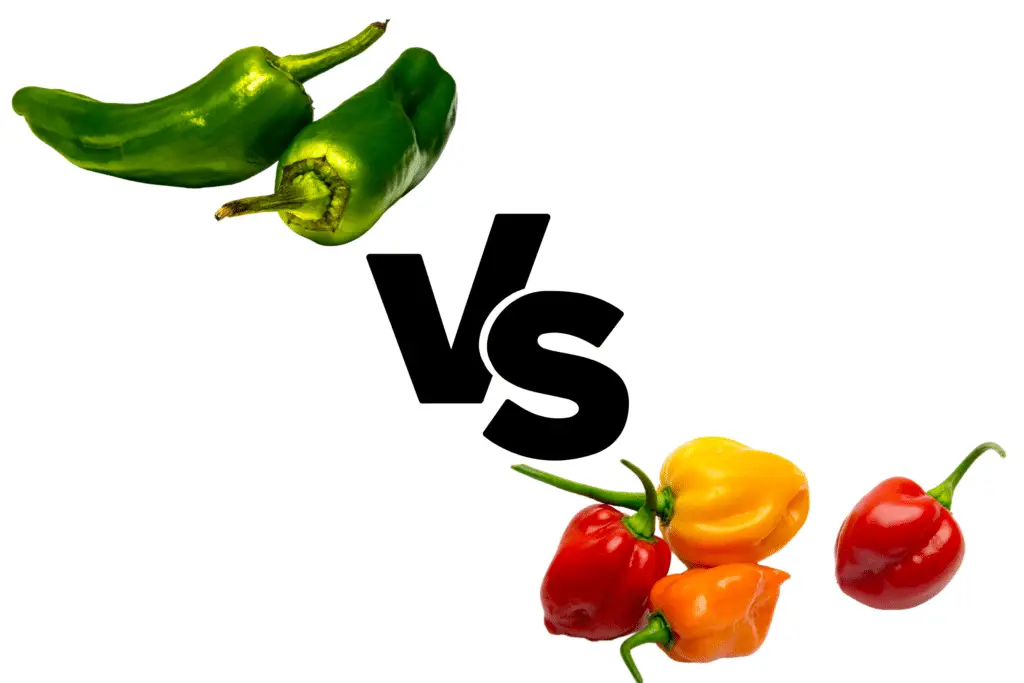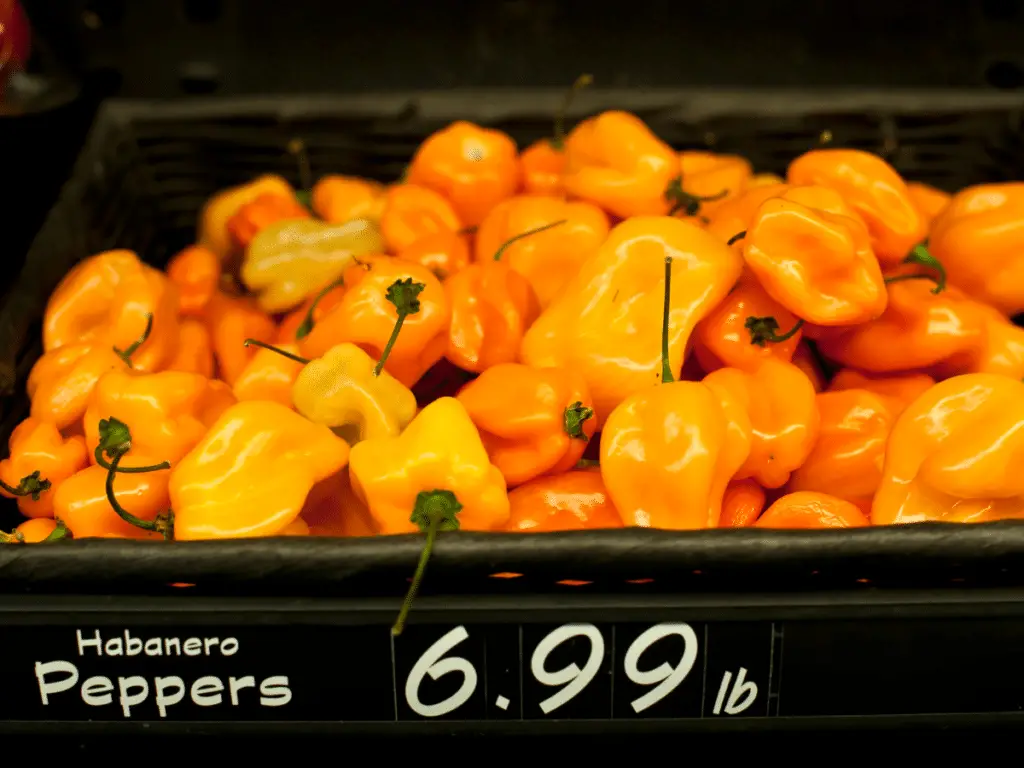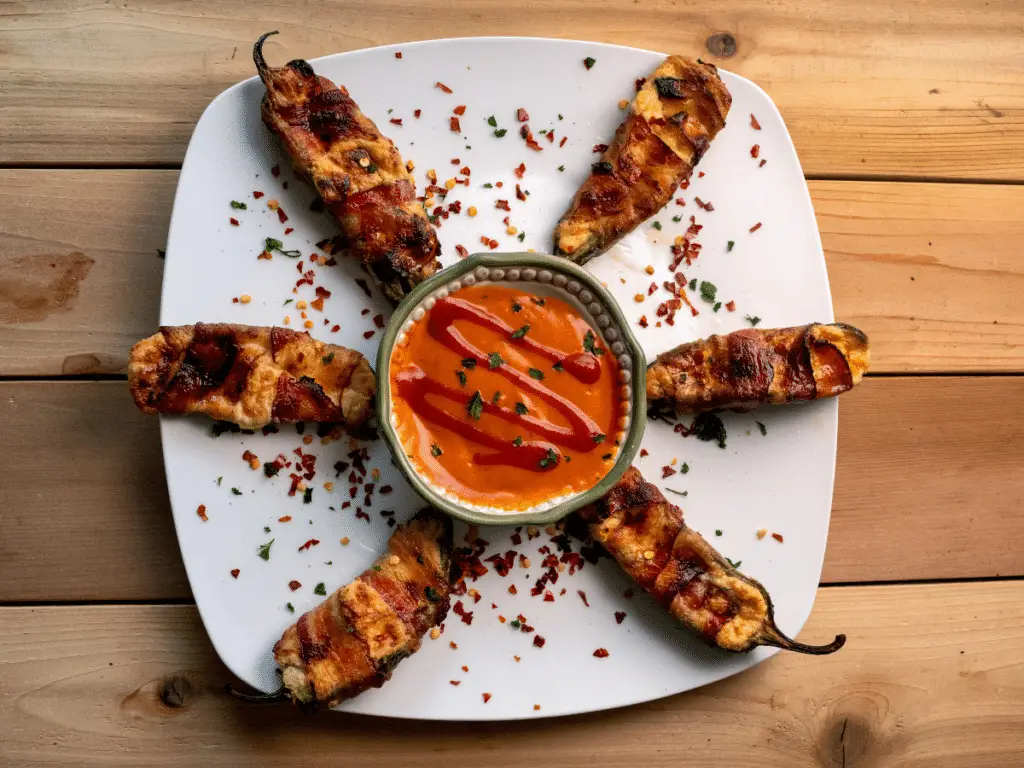If you thought jalapeño peppers were spicy, just wait until you hear about habaneros!
Jalapeños have a heat range of 2,000-8,000 SHU and are generally considered the mildest spicy pepper. On the other hand, habaneros are very spicy, with a Scoville range of 100,000-350,000! Jalapeños are sweet, whereas habaneros are citrusy and floral – once you get past the spiciness! As with most peppers, they’re both rich in vitamin C.
Read on for an extensive guide detailing the differences between these two peppers.
Comparison – Differences between jalapeño peppers and habanero peppers

Let’s take a look at the similarities and differences between these two peppers based on the following criteria:
- Jalepeño peppers vs habanero peppers heat level
- Jalepeño peppers vs habanero peppers flavor
- Jalepeño peppers vs habanero peppers texture
- Jalepeño peppers vs habanero peppers size and shape
- Jalepeño peppers vs habanero peppers nutrition
- Jalepeño peppers vs habanero peppers cost and availability
- Unique difficulties
- Substitutions
| Criteria | Jalepeño Pepper | Habanero Pepper |
|---|---|---|
| Heat level | 2,000-8,000 SHU | 100,000-350,000 |
| Flavor | Sweet and bright | Bright, citric, spicy |
| Texture | Smooth with a tough skin | Wrinkly |
| Size | 2-3″ | about 2.5″ |
| Shape | Rounded cones | Pointy cones |
| Nutrition (per 100g) | 29 Calories 144% DV Vitamin C | 40 Calories 240% DV Vitamin C |
| Substitutions | Serrano pepper | Scotch Bonnet peppers |
Jalepeño peppers vs habanero peppers heat level (in Scoville heat units)
Habanero peppers can be up to 175 times hotter than jalapeños!
Jalapeños have an SHU rating that ranges from 2,000-8,000. But habaneros are as hot as 100,000-350,000 SHU!

Clearly, these two peppers are in totally different ballparks.
Jalepeño peppers vs habanero peppers flavor
Jalapeño peppers are sweet with a spicy kick.
Habaneros are incredibly spicy with floral and citrus undertones. You just have to handle the heat in order to reach them!
Jalepeño peppers vs habanero peppers texture
Habanero peppers and jalapeño peppers are both mostly smooth.
Jalepeño peppers vs habanero peppers size and shape
Jalapeños are 2-3 inches long.
Despite their extreme heat, habaneros are quite small – ranging from 1-2 ½ inches.
Jalepeño peppers vs habanero peppers nutrition
Habaneros are potentially incredibly anti-inflammatory due to their high capsaicin content.
Both jalapeños and habaneros are low in calories and high in Vitamin C. Vitamin C is an incredible antioxidant that fights free radicals in your body, potentially helping prevent cancer.
Cost and availability
Jalapeños and habaneros cost about the same per pound, although you’re more likely to find fresh jalapeños in your local grocery store.

Unique difficulties
A unique difficulty that both peppers share is their large SHU range. It can make it hard to know how spicy your pepper is going to be!
You have to be incredibly careful when working with all hot peppers, but habaneros are VERY hot. Be sure to wear gloves and avoid touching your eyes.
Can you substitute jalapeño peppers for habanero peppers or vice versa?
You can’t substitute jalapeño peppers for habanero peppers or vice versa. Habaneros can be over 100 times hotter than jalapeños.
Jalapeño peppers – a complete overview
Many of us love to explore the full range of capsaicin and try the hottest peppers imaginable. Others never venture further into the world of true heat than watching The Hot Ones and admiring Lorde’s unshakeable aplomb.
The humble jalapeño is for both groups. Keep reading to find out all about this popular pepper!
Heat
Jalapeños range from 2,000-8,000 SHU.

Red jalapeños are spicier than green jalapeños because they’re more mature. The riper the pepper, the more capsaicin it contains – in other words, it gets spicier over time.
Size isn’t a very good indicator of jalapeño spiciness. Color is the main factor!
Flavor
Jalapeños are sweet with a spicy bite.
Size, shape, and texture
Jalapeños are on the smaller side, ranging from 2-3 inches in length.
They’re smooth, round, and cone-shaped.
Nutritional content and potential health benefits
Some potential health benefits of jalapeño peppers are:
- Preventing ulcers
- Battling infections
- Boosting heart health
- Aiding in weight loss
One raw cup of jalapeños contains:
- 26 calories
- 177% DV Vitamin C
- 20% DV Vitamin B6
- 10% DV dietary fiber
Cooking with jalapeño peppers
Jalapeños are commonly found on nachos, in burritos, and in tacos. Besides Mexican cuisine, they’re used all over the world to add some moderate heat to dishes.

Chances are good you’ve had a jalapeño popper before since they’re a pretty common restaurant appetizer, but have you ever tried a bacon-wrapped jalapeño?
Substitutions for jalapeño peppers
Serrano peppers are the best jalapeño pepper substitute. Mild serrano peppers have 10,000 SHU, which is in the range of spicy jalapeño pepper.
They also share a sweet flavor.
Freezing, drying, and preserving jalapeño peppers
Some people can’t handle raw jalapeños and can only eat them pickled. So try pickling them at home!
Other ways to preserve jalapeños include canning, drying, and freezing them.
A fun project is to grind up your dried jalapeños to create spicy chili powder!
Habanero peppers – a complete overview
Habanero peppers are popular in salsas and hot sauces, but you’re less likely to find these tropical, slightly fruity peppers in common recipes because of their heat.

Heat
Habaneros range from 100,000-350,000 SHU.
All we can say is, be careful!
Flavor
Despite their extreme heat, habaneros actually have a complex flavor profile full of floral and citrus notes.
Unlike some peppers, there’s more to this little guy than just the heat.
Size, shape, and texture
Habaneros are roughly 1-2 ½ inches long.
The best way to describe them is as small bell peppers that have a pointed tip.
Nutritional content and potential health benefits
One habanero pepper has 18 calories and 108% DV Vitamin C.
Some potential health benefits of habanero peppers are:
- Fights free radicals
- Improves eye health
- Anti-inflammatory
Cooking with habanero peppers
First off, wear gloves and do NOT touch your eyes when working with habaneros!
People usually take the seeds out of habaneros and then saute them to be used in Mexican cuisine.

You can even make your own hot sauce out of habanero peppers!
Substitutions for habanero peppers
The best substitute for habanero peppers is the Scotch Bonnet pepper. They have the exact same SHU rating – 1,000-350,000 – and share a floral flavor.
Freezing, drying, and preserving habanero peppers
Habanero peppers can be pickled, canned, dried, or frozen for preservation.
